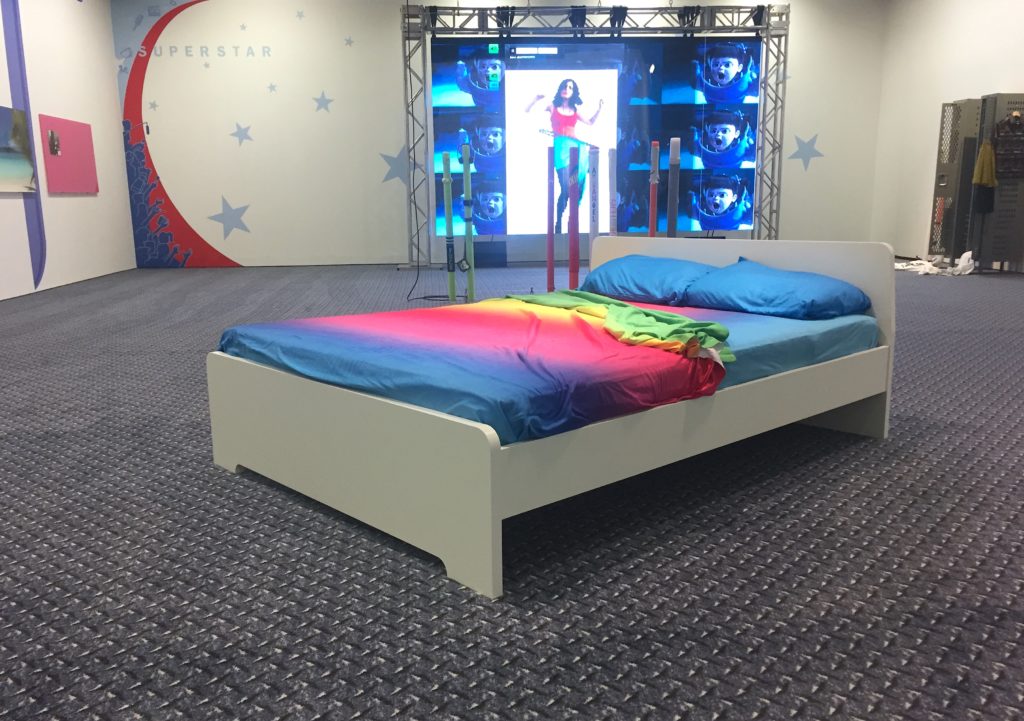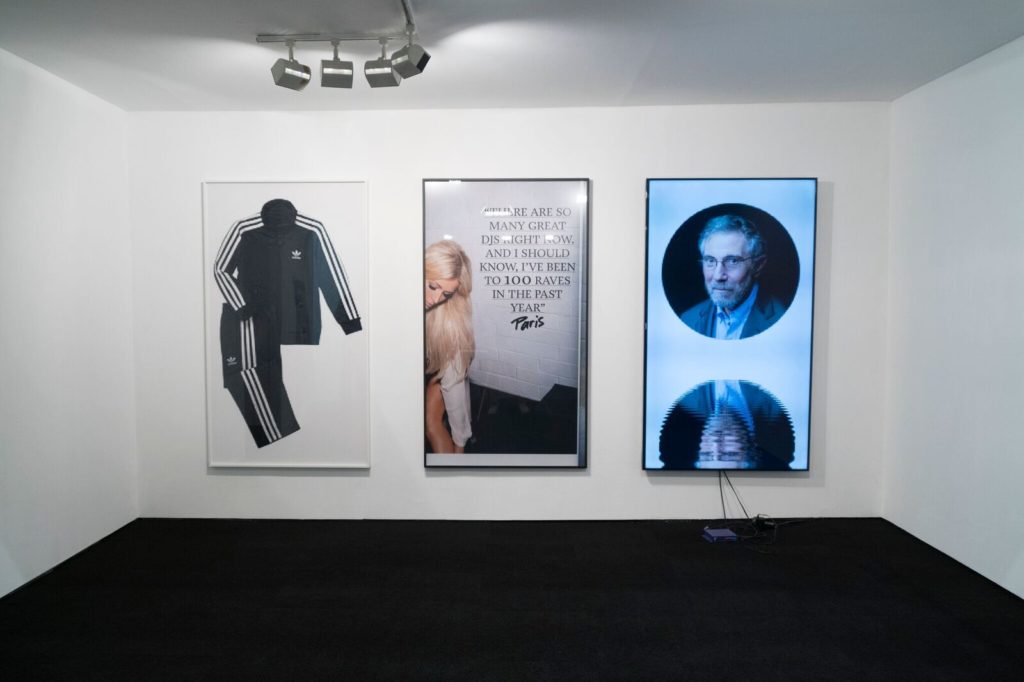On View
Cory Arcangel and Olia Lialina Embrace Asymmetric Warfare and the Internet Age
A technologically-savvy show lands at the Kitchen.

A technologically-savvy show lands at the Kitchen.

Katy Diamond Hamer

In May 2016, Charles M. Blow, an op-ed columnist at the New York Times, wrote an article called “Trump’s Asymmetric Warfare”, where he notes the president-elect’s abilities to exploit weakness in his enemies, which he views as monolithic forces. Blow states, “Conventional forms of political fighting won’t work on this man. Truth holds little power, and the media is still enthralled by the monster it made.” This is the first page of a source book accompanying the exhibition and opening of “Asymmetrical Response” at the Kitchen.
The artists in the show, Cory Arcangel and Olia Lialina, who have been friends since 2003, have joined forces for its second iteration, which focuses on interacting with and manipulating our digital realm. First shown at the Western Front in Vancouver in fall 2016, the touring exhibition now in New York, differs from the Canadian version incorporating subtle notations foreshadowing the upcoming Presidential inauguration.
Not necessarily intended to be shown on the eve of a Trump presidency, the exhibition unintentionally remarks on a global political climate, more relevant than ever. “It became a perfect storm regarding a project developing there that we could bring here,” Tim Griffin, executive director and chief curator at the Kitchen, said in an interview. “This iteration has changed, also the New York audience is more familiar with Cory. At the same time it becomes a unique platform to have his dialogue with Olia over the years be brought to a larger public, beyond the aficionados.”

Olia Lialina, Liquid Crystal Curtain (2016). Photograph by Katy Diamond Hamer. Courtesy of the artist and the Kitchen.
Spanning from 2008 to present, “Asymmetrical Response” is a selection of artworks both dissecting and utilizing readily available technology. It is expected and unexpected, at times nostalgic and in other moments fresh. Arcangel and Lialina both have a history of exhibiting digitally engaging work, commenting on a technology that is quickly obsolete. She has had an extensive career (since 2005) as a GIF model, using her body to create digital loops that are then used inexplicably throughout the Internet. Lialina has written extensively on new media and is the co-founder of Geocities Research Institute. Cory Arcangel is represented by Team Gallery, and has exhibited at the Hamburger Bahnhof in Berlin, the Whitney Museum, New York, Lisson Gallery (London and Milan), the Metropolitan Museum of Art, New York and many others. The two artists have never shied away from the political during their careers.
“Most of our conversations about this exhibition happened before the election,” says Kitchen curator Lumi Tan. “There were already so many asymmetrical responses that were present in the media and post-election this show has taken on a completely new relevance. We wanted to make sure that it is seen in a political context because their work can appear really fun, colorful and energetic, but there really is this quite sinister undertone, referencing how the Internet uses us.”

Cory Arcangel (L to R): Imgres (2016), 100 Raves (2016), Krugman / Lakes (2016). Courtesy of the artists and the Kitchen.
The most glaring political work in the show is a trio of digitized newspaper clippings by Olia, wherein she applied popular web techniques of the time onto photographs. For instance, Online Newspapers, Post factual Edition, Frankfurter Allegemeine (2017), features President-elect Trump and the future First Lady, Melania. Lialina has applied a simple gesture, programming the movement of a mouse over the subject’s hair, accompanied by a flurry of stars. The stars falling around the future First Lady’s flowing hair, feeling both ironic and insincere. It’s a simple yet surreal action, not unlike the entire election cycle.
The installation which is very specific in object placement as well as an accessible height to all the 2D work hanging on the walls. On the install planning Arcangel stated, “We designed the show in 3D,” making reference to the amount of time 3D rendering requires, “so we have been working on it for a while.” Lialina added, “We looked not only for works to fill the gallery but made sculptures at the same time.” Arcangel agreed, “Each show started with the space. This is our first complete collaboration, but we’re often in the same group shows and Olia’s name comes up as someone ‘people also search for’ when you Google my name.” With interests and aesthetics similar in vein, both Arcangel and Lialina are archivists, hackers, and makers. In this instance, together their gestures have a political weight and resonance that couldn’t be more timely with Obama’s exit and Trump’s entrance.
Olia Lialina is exhibiting a 2011 animated digital work, (Nothing You Can Compare to Your Neighborhood Hoe), on a screen nearly the size of the back wall of the gallery complete with an industrial metal frame not unlike the framing one might see on the stage of an outdoor concert venue. The artist sought out her own “Animated Gif Model” from 2005 via Google image search and found a Tumblr containing the GIF along with other Internet tropes from the time: appropriated photos, tiled backdrops, poor quality audio files. The work functions as an archive of digital space and time but also has a painterly quality, the movement on the screen jagged not unlike the abstraction employed by the Futurists. Parallel to this work is a suspended clear panel, with several of Cory Arcangel’s “Screen-Agers” avatars made of pool noodles, dressed in everything from a ‘tailored Nike sweatpant leg’ to ‘Beats By Dre headphones’, according to the descriptions.
Much like us, they want to be entertained, are fashion conscious, and are the distilled parts of what we represent through external adornment. Similarly to (Nothing You Can Compare to Your Neighborhood Hoe) the “Screen-Agers” with individual titles such as Fucks (2015), You Only Live Once (2014), and Boss (2015), no matter how aware of their present moment, like the Internet of the past or a website never updated, are frozen in time. These sculptures are conceptual representations of life, destined to remain still.
Cory Arcangel and Olia Lialina: “Asymmetrical Response” is on view at the Kitchen in New York from January 11–February 18, 2017.